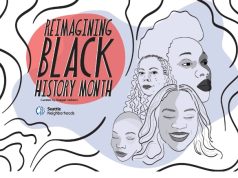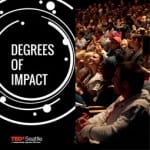 If you missed the idea-potent meeting-of-minds that was TEDx Seattle 2013, either on-site at the Seattle Children’s Theater or online via LiveStream, here’s a synopsis of each of the presentations, in two sentences or less, depicting how each speaker made impact at the event, themed “Degrees of Impact.”
If you missed the idea-potent meeting-of-minds that was TEDx Seattle 2013, either on-site at the Seattle Children’s Theater or online via LiveStream, here’s a synopsis of each of the presentations, in two sentences or less, depicting how each speaker made impact at the event, themed “Degrees of Impact.”
From Brad Lichtenstein, renowned mind/body medicine researcher: “Breath has a natural healing power. So how come when someone asks us a difficult question, or when we try to remember something, we hold our breath?” The “Breath Guru” advises to “inhale deeply and exhale your existence into the world!” Breath more, live more!
From Matt Chan, reality TV producer of “HOARDERS,” among others: The key to successful “Reality TV” is to know your audience and tap into their shared experiences. You can be a “wine hoarder,” but not many people will relate. You CAN pitch Hollywood from Seattle, you just have to know how to commute and protect your airline seat against spatial hoarders.
From Lisa Weeks, founder of FILTER talent: “Weird is relative…and cool…and mathematical! ” (W+T) x (C+A)-BS=N. Translation: Weirdness plus Time multiplied by Consistenty and Authenticity, minus Bullshit=Normal. “COSPLAY” = Costumes plus Play. On screen is Lisa at Anime Expo, with her tribe, in 24th century garb, in a galaxy far, far away.
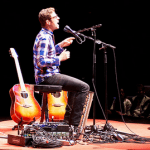 From BERNHOFT: The Norwegian performer brought down the house by creating a different kind of “digital one-man band.” How does he do it? By creating live, recorded loops of his vocal and instrument sounds in real time. Right before your eyes and ears, Bernhoft becomes both the backup chorus to his vocal tracks and the backup band to his solo guitar riffs. This man deserves a one-man show at EMP.
From BERNHOFT: The Norwegian performer brought down the house by creating a different kind of “digital one-man band.” How does he do it? By creating live, recorded loops of his vocal and instrument sounds in real time. Right before your eyes and ears, Bernhoft becomes both the backup chorus to his vocal tracks and the backup band to his solo guitar riffs. This man deserves a one-man show at EMP.
From Kelly Bloom, PhD: “It’s never too late to be the person you can become.” For Kelly, it meant getting a PhD in “Parks, Recreation and Leisure.” Why? In the billion-year, cosmic magnitude of time, we need to appreciate that THIS is our moment: “I am temporary” on this planet was her realization. “My whole life is the “in-between.” Act NOW!
From Yoli Chisholm, digital marketer at Microsoft: “He who listens to the voice of an elder is like a strong tree. But he who covers his ears is like a branch in the wind,” mused the South African-born entrepreneur. “Your founders and ancestors have stories that should give you fuel.” Learn from them. They are who you are!

From Kyle Kesterson: FEAR can be a powerful catalyst for change especially when you can channel your reaction to Fear from one which keeps you from acting to one that keeps you running in the opposite direction.
From Dr. Quinton Morris, professor at Seattle U, community mentor and virtuoso violinist: Creativity and artistry are only one part of the equation in the success of talented, young musicians and other artists. Another integral part is the business side, the cost accounting and management that makes the life of a musician more viable and profitable.
From John Sangiovanni, co-founder of mobile advertising leader Zumobi: It’s the “wildcard” in your past that defines your unique marketability and stature. It’s the “hyphens” between marketer-performer-technologist that is where the action is. Like the time when John became a Teenage Mutant Ninja Turtle character actor at Walt Disney World and learned the art of branding in three-dimensions. When Sangiovanni worked at Microsoft Advanced Research they used this same principle of non-linearity to create the first generation of “tiles” in a “zoom space,” the DNA for Windows 8!
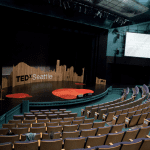 From Nick Berry, datamining guru and password security expert, now at Facebook: 10% of Websites can be accessed using passwords found in a dictionary of 100 words or less. 26.8% based on 300 terms. 50% through just 526!
From Nick Berry, datamining guru and password security expert, now at Facebook: 10% of Websites can be accessed using passwords found in a dictionary of 100 words or less. 26.8% based on 300 terms. 50% through just 526!
From Zac Cohn of Parkour Visions: Like the acrobatic, mind-over-matter art of Parkour, a one-page “Business Model Canvas” can help you synthesize the shortest distance between two points, business startup and success. Compare the above “one-sheet” to an unread marketing plan that is hundreds of pages long. Bonus: You can do a standing backflip at the end of a TED Talk with the right degree of training.
From Cheryl Stumbo, one of the last lines of defense against the attack of a crazed gunman on the Jewish Federation of Seattle: Victims of gun violence owe it to themselves and to society to be the most outspoken advocates for gun control change.
From Philip Parker, PhD., Gates Foundation: Very soon, the data processing power in our handheld smartphones will be not simply media players, but automated Creators of content, the publishers of auto-researched books and white papers in the languages most needed to educate those in unserved markets.
From Greg Gottesman of Madrona Venture Group: The most daunting and debilitating debt problem the United States faces, one trillion dollars strong, dwarfs credit card debt and even the rising costs of health care. It is the massive amount of student debt we are heaping upon our nation’s youth through student loans. Tuition costs have soared to 1000% in the same time period that the clamor over healthcare costs has arisen, even though healthcare’s soaring costs are but a fraction at 250%. New legislation alone cannot afford a solution at sufficient scale. Only fundamental changes in education, options for online vs. offline learning, and the way we approach secondary education in general hold a legitimate answer.
From Eric Stowe of Splash: The proliferation of charities, while well-intentioned, is a flawed concept. A multitude of charitable programs fractionalize resources instead of coordinating contributions that need to be precision-focused. While it’s easy to demonstrate success in isolated communities, the pilot efforts rarely roll-out to larger populations, missing the people, and the premise, entirely. Solution : Empowering local businesses to take over and sharing the models that work with business and governments hold the greatest promise for leveraging charitable dollars.
 From Brian Heather of SolTerra: Incorporating green gardens into architecture, like creating a living wall system holding more than 500 plants for the University of Washington’s College of Built Environments, offers enhanced benefits for energy management and LEED building compliance.
From Brian Heather of SolTerra: Incorporating green gardens into architecture, like creating a living wall system holding more than 500 plants for the University of Washington’s College of Built Environments, offers enhanced benefits for energy management and LEED building compliance.
From Vicki Robin: Your supermarket holds only three days worth of food for a local population. In a future “crisis,” (if that isn’t enough of one), or a distribution shortage, we need to find food within 10 miles of where we live, a concept called Relative Eating. Start by feeding your family 50% local food with 50% industrial food and see if you can cultivate the concept of local eating right in your own backyard.
From Matika Wilbur: Embarking on a photographic journey of the native peoples in her heritage was a catharsis, not only in recapturing the past, but reinventing the present and continuing the oral, and now visual tradition of a culture and its narrative through silver gelating photography.
From Jim Olson, M.D., medical visionary and anti-cancer crusader at Fred Hutch: Plants and animals make their own drugs to survive in the wild. Like a key fitting into a lock, these perfectly crafted molecules can shutdown infections or paralyze prey. Seattle’s Fred Hutch scientists have discovered how to create thousands of variations of these amazing drugs out of “optides,” or small proteins. Enter Citizen Science: Project Violet is the name of a new program where individuals can help uncover one of the 25,000 strains of new drug candidates that might otherwise go unexplored – and by sharing the drug discovery adventure, you may learn that you’ve made a lifesaving discovery. For a $100 donation, your name may go down in history for finding a cure since you are free to give the new natural drug treatment your own name.
Dr. Olson and his team invented Tumor Paint, a Scorpion toxin based drug that makes cancer cells light up so that surgeons can distinguish cancer from normal tissue while operating. They also invented a way to test multiple different chemotherapy drugs in a patients’ tumor to prioritize the best drugs or combinations and eliminate in effective drugs.
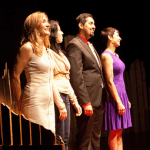 From the four TEDx Seattle Curators, Barrie Cohen, Kartik Rishi, Carly Slater and Marnie Weber, and Project Manager Christie Youde: Over a year’s worth of planning, culling speakers from countless applications, and more than 65 auditions down to 18, and then hand-picking an audience on the basis of their “Spreading Good Ideas,” will pay dividends for generations.
From the four TEDx Seattle Curators, Barrie Cohen, Kartik Rishi, Carly Slater and Marnie Weber, and Project Manager Christie Youde: Over a year’s worth of planning, culling speakers from countless applications, and more than 65 auditions down to 18, and then hand-picking an audience on the basis of their “Spreading Good Ideas,” will pay dividends for generations.
This dedicated group, along with their devoted volunteers, has harnessed the power of ideas to transform and empower a great many, and done a service of extraordinary magnitude not only for Seattle, but for the larger Internet of ideas. We owe them all an enormous debt of gratitude for their tireless efforts.
Link up for more on TEDx Seattle 2013 Speaker Biographies For a visual overview, check out the TEDx Seattle 2013 Flickr gallery [24×7]













